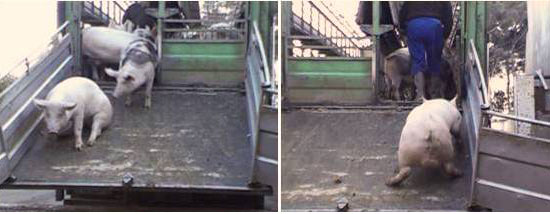| Good feed | 1. Absence of prolonged hunger | Feed provision |
| 2. Absence of prolonged thirst | Water supply | |
| Adequate housing | 3. Comfort during rest | Floor Bedding materia |
| 4. Thermal comfort | Shivering Panting Huddled animals |
|
| 5. Ease of movement | Slips, falls, density of animals in the vehicle, density of animals in the holding pens | |
| Good health | 6. Absence of injuries | Limping, bodily wounds |
| 7. Absence of illness | Animals incapable of moving by themselves, dead animals | |
| 8. Absence of pain due to mishandling | Efficiency of stunning | |
| Appropriate behavior | 9. Good human-animal relationship | Vocalizations |
| 10. Positive emotional state | Immobile animals, or those that move backwards |
Transportation and unloading
During the unloading, the animals’ ease of movement is evaluated based on the percentage of animals that slip (loss of balance without touching the floor) and/or fall (any part of the animal besides the hooves touch the ground). On the other hand, fear during unloading is also evaluated based on the percentage of animals that remain immobile during at least 2 seconds (Figure 2), or move back suddenly within the observation zone (Figure 3).

In this phase, some indicators during transportation are also registered. One of these is effective temperature, which is evaluated based on the presence of trembling animals (stress due to cold) or panting animals (stress due to heat). After unloading, the interior of the vehicle is inspected for dead animals or animals that are incapable of moving by themselves, due to lesions or illness. These measures are included within the absence of disease criterion. Lastly, the availability of space is calculated based on the surface area of each floor and the total weight of transported animals. The presence of bedding material on the vehicle floor is also taken into account.
Transport to holding pens
Once the animals have descended from the vehicle and are headed towards the holding pens, the presence of limps is evaluated when the animals are moving over a flat area. For this purpose, two types are considered according to their severity. Light limps when the animal has difficulty walking but can still support itself on all fours, and serious limps where the animal cannot support itself on all fours.
Stabling in holding pens
In this phase 4 criteria are taken into consideration. The first two are the absence of hunger and thirst. The first is calculated based on the number of drinking troughs per animal, their functionality and cleanliness. For the second, the availability of feed for animals that have been held more than 12 hours in the holding pens is evaluated.
The third criterion is that there be an adequate effective temperature. Cold induced stress is evaluated based on the presence of shivering animals or those that huddle together when they are laying down Heat induced stress is measured based on the presence of panting animals. The last criterion is that there be a comfort while resting, which is evaluated based on the area available per animal.
Stunning and slaughter

During the transport of the animals for stunning, the human to animal relationship is evaluated based on the presence of acute vocalizations (squeals) in the group. For this, the presence or absence of vocalizations is registered in periods of 20 minutes, as well as the number of animals vocalizing at the end of this period.
During the stunning, whether unconsciousness is induced painlessly and stress free is evaluated, as well as whether this is maintained until the death of the animal. For this, right after stunning and after the bleeding, the absence of corneal reflexes, rhythmic breathing, intents to wake, and vocalizations are evaluated.
Carcass
Lastly, the absence of lesions is evaluated based on the wounds on the half-carcass (Figure 4). For this, the carcass is divided into 5 areas (ears, head, back, trunk, hindquarters and extremities). Each part is evaluated independently based on the following scale: 0, without lesions or with lesions less than 2 cm; 1, more than one lesion larger than 2 cm; 2, more than 10 lesions larger than 2 cm or any penetrating lesions. The carcasses are marked as 1 or 2, if there is any area with a mark of 1 or 2, respectively.
The Welfare Quality® Project has edited a book where different measures and their evaluation methodology are detailed (www.welfarequality.net).




